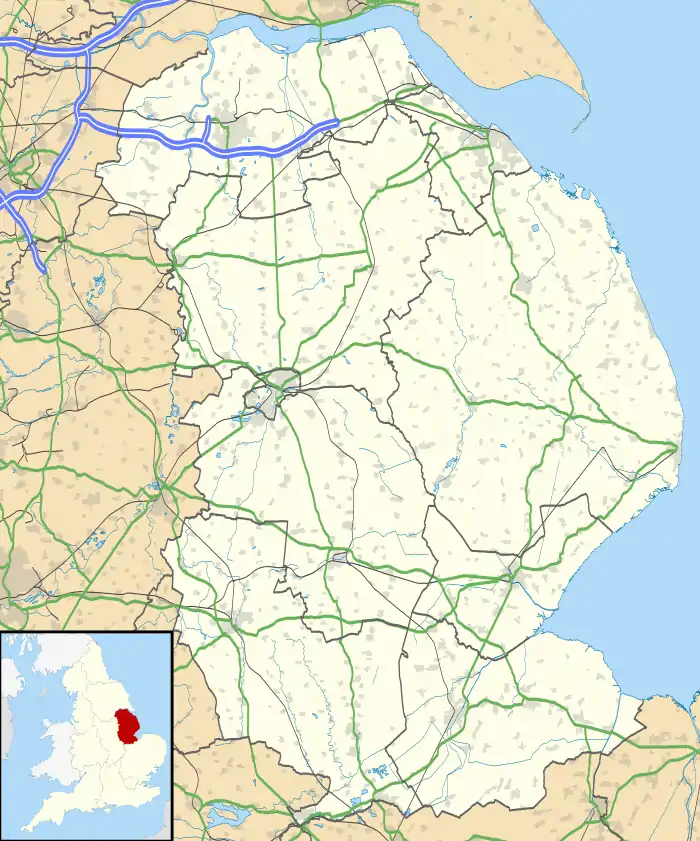Hawthorpe, Lincolnshire
Hawthorpe is a hamlet in the South Kesteven district of Lincolnshire, England, and the civil parish of Irnham, Bulby and Hawthorpe. It is west from the A15, east from the A1, and 5 miles (8.0 km) north-west from the town of Bourne.

| Hawthorpe | |
|---|---|
 Hawthorpe Location within Lincolnshire | |
| OS grid reference | TF 048275 |
| • London | 95 mi (153 km) S |
| District | |
| Shire county | |
| Region | |
| Country | England |
| Sovereign state | United Kingdom |
| Post town | Bourne |
| Postcode district | PE10 |
| Police | Lincolnshire |
| Fire | Lincolnshire |
| Ambulance | East Midlands |
| UK Parliament | |
Hawthorpe is mentioned in the Domesday Book as "Awartorp", in the Beltisloe Hundred of Kesteven. It comprised 2 households, 2 villagers and 4 freemen, with 2.9 ploughlands, a meadow of 8 acres (0.032 km2) and woodland of 320 acres (1.3 km2). In 1066 the Lord was Healfdene; after 1086 Lordship was given to Alfred of Lincoln.[1][2]
In the 1872 White's Directory the two hamlets of Bulby and Hawthorpe were grouped as Bulby-cum-Hawthorpe forming the eastern side of Irnham parish, being a joint township with a population of 180 in 1,767 acres (7.2 km2) "of fertile land". About 1,000 acres (4.0 km2) of Bulby-cum-Hawthorpe land was purchased by Rev. William Watson Smith in about 1840, who built on it the Elizabethan-style Bulby House and grounds. By 1872, Bulby House and 1,100 acres (4.5 km2) of township land was owned by Gilbert Heathcote-Drummond-Willoughby, 1st Earl of Ancaster (Lord Aveland), who was lord of the manor. A moated area evident at the time was said to be the site of Bulby Hall which is "supposed to have been burnt down in the Barons' wars".[3]
In the 1885 Kelly's Directory Hawthorpe is written as having an 1881 population of 70, and as a joint township with the hamlet of Bulby for the support of the poor. Hawthorpe belonged principally to Lord Aveland, who lived at Bulby House.[4]
Listed buildings in the hamlet centre on Hawthorpe Farm, including a 17th-century farmhouse, 19th-century cottages, and 17th- to 19th-century barns and stables, all Grade II.[5][6][7]
References
- “Hawthorpe" Archived 5 February 2015 at the Wayback Machine, Domesdaymap.co.uk. Retrieved 8 April 2013
- "Documents Online: "Hawthorpe, Lincolnshire", Folio: 358r, Great Domesday Book; The National Archives. Retrieved 8 April 2013
- White, William (1872), Whites Directory of Lincolnshire, p. 597
- Kelly's Directory of Lincolnshire with the port of Hull 1885, p. 496
- Historic England. "Hawthorpe Farmhouse (1062809)". National Heritage List for England. Retrieved 8 April 2013.
- Historic England. "Hawthorpe Farm Cottages (1062810)". National Heritage List for England. Retrieved 8 April 2013.
- Historic England. "2 Barns, Stables and Farm Buildings, Hawthorpe Farm (1146884)". National Heritage List for England. Retrieved 8 April 2013.
External links
 Media related to Hawthorpe at Wikimedia Commons
Media related to Hawthorpe at Wikimedia Commons- "Hawthorpe, Lincolnshire", A Vision of Britain through Time. Retrieved 8 April 2013
- "Irnham", Genuki.org.uk. Retrieved 8 April 2013